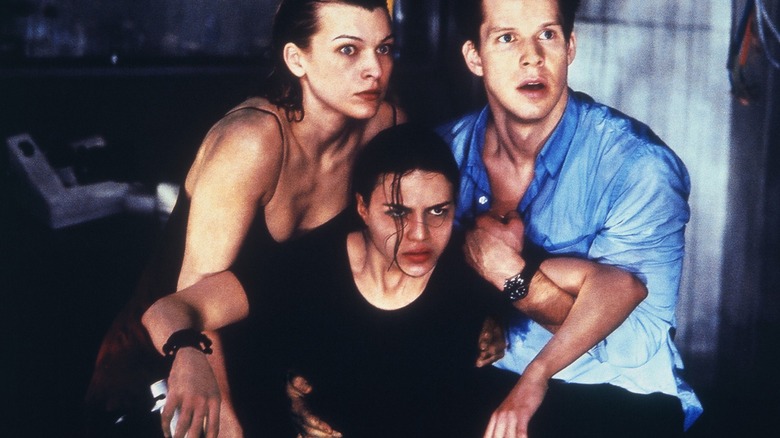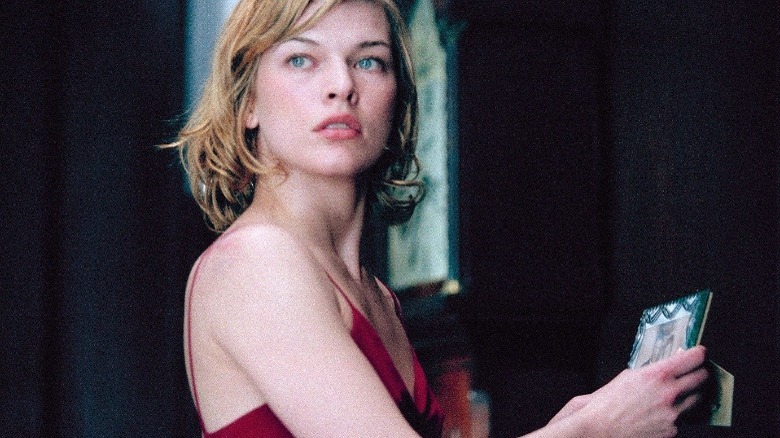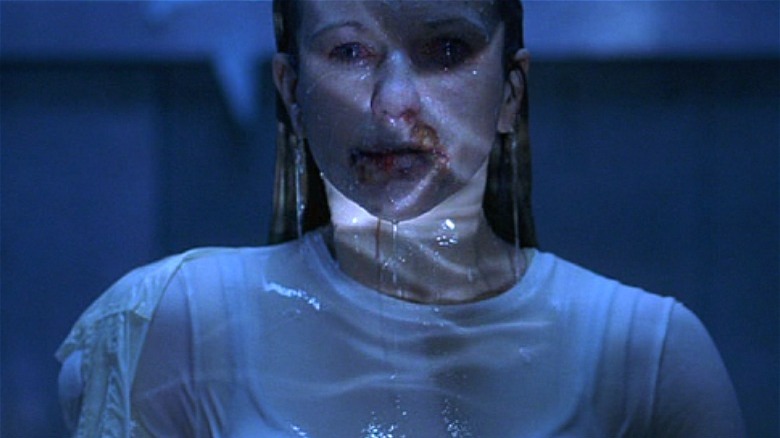Paul W.S. Anderson Had To Fight The System To Make His First Resident Evil Film
In 1995, Paul W.S. Anderson broke Hollywood's video game adaptation curse with "Mortal Kombat," which was a shining example of a video-game-based blockbuster that could spawn into a long-standing franchise. Riding high on the fresh success of "Mortal Kombat," Anderson decided to tackle yet another major game franchise that had a history of failed movie adaptations. Capcom's survival horror game series, "Resident Evil," offered ample material for a potentially riveting action-horror adaptation. Anderson, who was a fan of the game franchise, saw this potential and decided to add his own spin to the premise. The result was 2002's "Resident Evil," which birthed a six-installment franchise so far removed from the games that it developed a distinct identity of its own.
Despite the franchise's flaws, Anderson's "Resident Evil" films offer a unique survival horror/kinetic action experience. The films follow the amnesiac Alice (Milla Jovovich), a covert operative who battles the corrupt Umbrella Corporation while navigating a zombie apocalypse triggered by the T-virus outbreak. Although Alice is not a character in the games, the films feature in-game characters like Albert Wesker and Claire Redfield to enrich a premise that bases itself loosely on the "Resident Evil" games. Despite mixed results, Anderson's "Resident Evil" films are enjoyable in their own right and fare much better than the recent attempt to adapt the game into a lackluster, insipid Netflix series.
But, was it easy for Anderson to make his first "Resident Evil" video game adaptation in 2002? While "Mortal Kombat" opened several avenues for the director, Anderson experienced massive pushback from the system while attempting to adapt the beloved game franchise. Here are some of the major challenges Anderson faced.
The Alice problem
In an interview with Thrillist, Anderson explained why adapting "Resident Evil" was a challenge at the time. Citing the character of Alice as the primary obstacle, Anderson said that a strong female lead in a video game franchise was "absolutely not acceptable" in mainstream Hollywood and that studios pushed for a male lead instead:
"I loved the [Resident Evil] video game...I think that the previous success that I'd had with 'Mortal Kombat' also allowed me to kind of force through a few things. I had a strong female lead back in the day when that was absolutely not acceptable in mainstream Hollywood movies."
In another interview, Anderson reiterated that a strong, level-headed female lead like Alice in a major franchise film was "not fashionable at all" and that he had to actively fight against this notion. The only example of a female-led video game movie at the time was 2001's "Lara Croft: Tomb Raider," in which Angelina Jolie assumed the titular role. Despite Jolie's cogent performance, the film failed to capture the essence of the "Tomb Raider" games and upheld the vapid sexualization of the character within the context of the male gaze.
Although Alice does emerge as a more compelling lead than Jolie's Lara Croft, the former is also oversexualized throughout the film series to a great extent. Nevertheless, Alice's emotional arc matures and comes full circle over the six films, and Anderson invests appropriate depth in the character, which is brought to life by Jovovich in remarkable ways. Take the epic laser-corridor scene as an example of Alice's growth since the 2002 film. Alice goes from a passive observer to an active participant (and survivor) of the laser-corridor trap in "Resident Evil: The Final Chapter," the final installment. The payoff, without a doubt, is massive.
Zombie movies were not a no-brainer back then
In his Thrillist interview, Anderson noted that the first "Resident Evil" positioned zombies front and center after a long dry patch for the subgenre, claiming "no one had made a zombie movie for 15 years." Despite the dramatic nature of Anderson's statement, zombie horror films were in fact on the decline, as audiences had grown tired of formulaic tropes. However, Anderson's "Resident Evil" did not reinvigorate zombie horror in the early 2000s—it was Danny Boyle's 2002 introspective survival horror, "28 Days Later," that managed to do so. When Anderson first pitched "Resident Evil" to studios, they had no way of anticipating the genre's resurgence. Naturally, there was a lot of uncertainty about how well audiences would respond to a video game film about a zombie apocalypse.
Despite these obstacles, Anderson managed to put "Resident Evil" out into the world. Although the film did not mirror the tense atmosphere of the games, it had a simple, effective story about a viral outbreak, with an emotionally resonant character at the center. Anderson also talked about the success of "Resident Evil", highlighting why people love it so much:
"It was an uphill struggle to get the movie made, but then the impediments suddenly became positive once people started seeing the finished film. People really loved Milla. She became the avatar that the audience members really rooted for and empathized with. The fact that zombies were back after 15 years, that wasn't a dangerous thing anymore, that was a fantastic thing, because people loved them and were terrified by them."
Anderson's "Resident Evil" does feel like a triumph. Not as a faithful video game adaptation, but as a kinetic action horror that stands its own ground. Sadly, the same cannot be said of the franchise's successive films.


